I frequently encounter eighteenth- or nineteenth-century dates, especially on the migration trail, that are not cited and which often derive from “online trees,” usually the FamilySearch Ancestral File, Rootsweb WorldConnect, or Ancestry World Tree. These days, I find it easier to determine whether any of the information is valid thanks to the many works and databases indexed at Google and Google Books. The following case suggests the variety of trails the researcher must be prepared to follow, from unverified online trees (which may hold important clues) to books and newspapers contemporary with the events mentioned (and which are sometimes flawed).
Walter Goold was born in Lyme, Connecticut 25 January 1759 and buried there 3 June 1817. A descendant’s generation charts identified Goold’s wife as Sally Latimer. When searching the Lyme Vital Records (in the Barbour Collection at NEHGS), I was able to confirm Walter’s birth and I found his burial on FindAGrave; his marriage, also at Lyme, only identified his wife as _____ Latimer. (Click on images to expand them.)
On Ancestry World Tree, several trees identified her as Sarah “Sally” Latimer, daughter of Henry and Sarah (Christophers) Latimer of New London, Connecticut. They also gave her a date of marriage at Montville, Connecticut on 15 January 1785 and a death in Orleans County, New York, on 26 April 1853.
In reviewing the charts online, I recognized lines of both her purported father and mother going back to Mayflower passenger William Brewster: Henry Latimer would be in the sixth generation and Sarah Christophers in the seventh, both descending from William’s son Jonathan2 Brewster. I went to the Mayflower Five Generations in Progress volume by Barbara Lambert Merrick. Both lines were confirmed to Henry Latimer as a child of his parents and Sarah Christophers’ father as child, but neither line continues to Sarah Latimer and her marriage. Henry Latimer died in New London in 1825, but he did not leave a will identifying heirs. I decided to do a bit a Google searching.
I did various searches for “Walter Goold” and “Sally Latimer” and “Henry Latimer” and “Sally Christophers” and “Sarah Christophers” and “Lyme” and “New London,” etc. Below are some the results I got after some detailed searches:
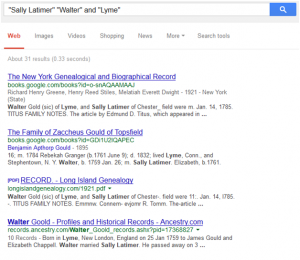 This led to a citation to their marriage in Montville in 1785 that I did not find in the Barbour Collection:
This led to a citation to their marriage in Montville in 1785 that I did not find in the Barbour Collection:

(Chesterfield is a village of Montville.)
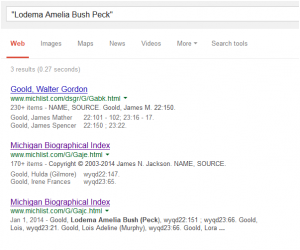 This led me to the website of the “Michigan Biographical Index,” which gave me links to two articles about Lodema:
This led me to the website of the “Michigan Biographical Index,” which gave me links to two articles about Lodema:
Both were identified as coming from the Detroit Society for Genealogical Research, which we have in the NEHGS library. The source turned out to be an article by Howard R. Goold on “Descendants of Robert Goold Who Came to America in the Year 1665,” and on page 100 of volume 22 [1959] was the family of Walter Goold, which showed the dates that had often been used online:
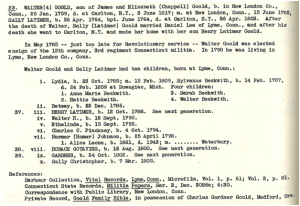
When I was almost done with my research, I saw one final record that really surprised me. In another person’s Ancestry World Tree was a reference to Sally from the Hale Collection:
The Detroit Society for Genealogical Research article states that Sally died in Carlton, New York, and I also found a FindAGrave entry listing her burial there in Fuller Cemetery. I thought at first that perhaps Sarah had two gravestones, one in New York and one in Connecticut. However, Family History Library film # 3246 was not a listing of the main body of the Hale Deaths and Burial Index; rather, it was an index to the New London Weekly Chronicle. After using this index to get the full entry, I had everything I needed:

Getting a death record in western New York in 1853 can be difficult. Usually you are limited to gravestones or death announcements (if that), since deaths were not civilly recorded. Even in Connecticut, while death records were kept in this period, the record usually did not list spouses, and almost certainly will not list parents. This newspaper’s death announcement of a New London native who died in western New York not only lists both of her spouses but also her father, giving me all the proof I need to extend her ancestors back in Connecticut and Massachusetts for seven more generations!
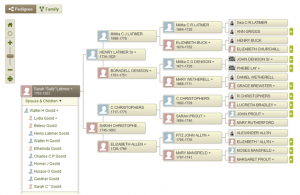
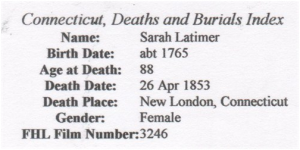
I look at those online trees with skepticism since I found my father (correct SS #, birth and death information) with parents and wife that I didn’t recognize.
Most discouraging is that Ancestry.com will not correct those obvious errors when someone links them to your relatives.
Exactly! I too have tried to notify them of an error, and in one case, an error I made!
Thank you so much for the post and telling it like it is! Many people don’t understand how much work is involved in tracing a line. They think it’s a simple find a book or a tree online with names and dates and call it done. I document with birth, marriage, and death records, wills, census reports if I can find them. I read the local histories. I look at neighbors. And look at online tree’s for nugets of. And love every minute of it! I have learned so much more about my family from doing just that. Far more then names and dates from a book or online trees would have given me. I get so much more from those books as well because I do know my family. It’s so much nicer to KNOW it’s my family and that I can prove it. I have learned your books and work is to be trusted. That matters. Can’t wait for the next one! Hopefully one on the Nelson family!
Agreed, although I do use Ancestry, Rootsweb, etc. for hints — and for those wonderful trees that actually have good sources.
Over the past several years, online research has opened up the world of genealogy to massive numbers of new family history buffs. This is wonderful to have more information and contacts out there for anyone, in particular those who have been researching for a long time and have hit brick walls in certain lines. However, it is distressing that there is so much misinformation being repeated from tree to tree without any sources other than RootsWeb, World Family Tree, or Ancestry Biological Index. All of these were meant to be “clues for further research” and not as a “source” unto itself. This is not being emphasized enough.
All these are taken not only from published records but predominantly from submitted Family Group Sheets of years ago and unsourced personal family histories. Years ago genealogy research required being close to a large library or repository, taking trips to other counties and states to review their records, or the reliance on a reputable genealogist. During the late 1800’s-early 1900’s it was big business to find you a Revolutionary Ancestor for submission to the DAR, SAR, etc. Submission requirements have grown and improved over the years.
Bottom line: Learn the basics of what qualifies as a “source” and where it has gotten it’s information. Go from there. It is so disheartening to find your family, of whom you have intimate personal knowledge, family Bibles, and family correspondence, listed in error just because someone thinks it fits their tree. I had to deal with eight different family tree owners of the birthplace of my own mother simply because the small village in Colorado had the same name as a town in Georgia. Nobody had bothered to see if the family had ever even been close to Georgia (which they had not,)
Thank you for making so much reliable information available to researchers for so many years. I was able to track many lines of my early family through New England thanks to your organization.
The most important tip is not to rely on extracts and indexes. Many of these are inaccurate, either due to mistakes (say, typographical errors) or to wilful additions of material by the abstractor. Many are the purported accounts of cemetery gravestones, for instance, which include maiden names that are not on the markers at all.
I agree! I found, or I should say didn’t find, one of my ancestors wasn’t in the index for 1790 Census but when I looked at the actual document there he was! Same can be said for books as well. Found a local history, Bethel, had a mention of a second marriage for Relief Bartlett Esty to Abner Foster of Freedom, Waldo, Maine. It was Freeman, Somerset, Maine that the marriage was also recorded. It was an important piece of puzzle. She was the sister of the wife of a known son of Abner Sr and Lydia Nelson and indicated Abner Foster (Jr) was from the area when added to all the other info. It was the clincher for me.
When I started researching I was very gullible and assumed online trees must be correct. Now I only use them for clues and to connect with serious researchers and people who have unique passed-down documents, pictures and information. You could spend all day everyday trying to correct other people’s mixed-up trees but I think that would be a waste of time. Still even my own tree with its thousands of original sources is not 100% perfect–families that I am working on are definitely “works in progress.” Just today I realized I had confused a brother (James Peace) with his sister (Tamar Billcliffe Peace) due to a transcription error, and that James must have died as a young child. I Improve it and correct it and document it better every day, but it is not perfect!
My online tree is a mix of accurate, “work in progress”, and a lot of exploring . I found myself “now where did I see that person?” enough times to want to have it so some of my branches are things I’m trying to confirm or may need later. I gave up trying to correct it a few years ago.